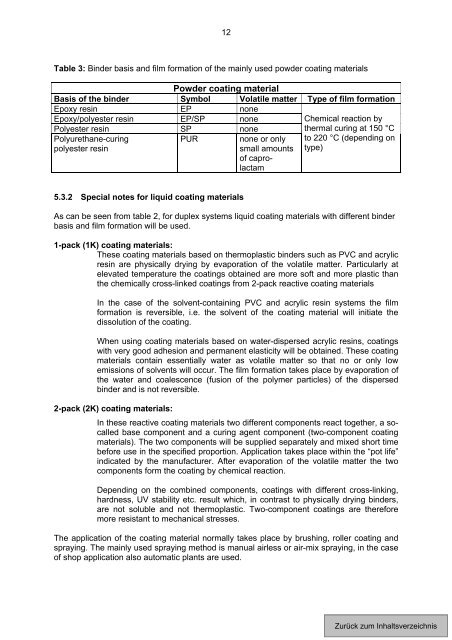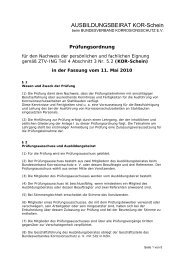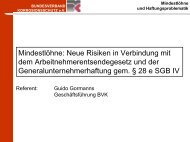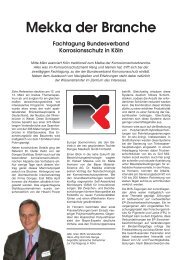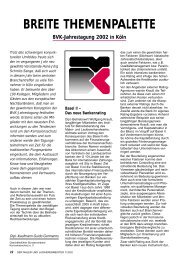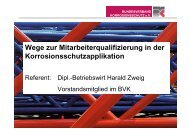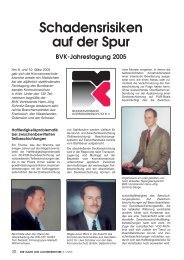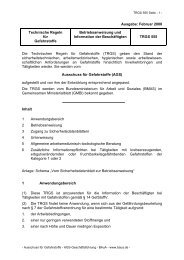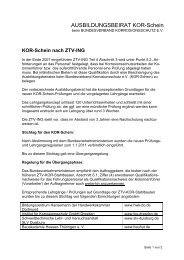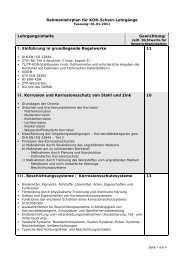Guideline of trade associations - VdL Verband der Lackindustrie e.V.
Guideline of trade associations - VdL Verband der Lackindustrie e.V.
Guideline of trade associations - VdL Verband der Lackindustrie e.V.
Create successful ePaper yourself
Turn your PDF publications into a flip-book with our unique Google optimized e-Paper software.
Table 3: Bin<strong>der</strong> basis and film formation <strong>of</strong> the mainly used pow<strong>der</strong> coating materials<br />
12<br />
Pow<strong>der</strong> coating material<br />
Basis <strong>of</strong> the bin<strong>der</strong> Symbol Volatile matter Type <strong>of</strong> film formation<br />
Epoxy resin EP none<br />
Epoxy/polyester resin EP/SP none<br />
Polyester resin SP none<br />
Polyurethane-curing<br />
polyester resin<br />
PUR none or only<br />
small amounts<br />
<strong>of</strong> capro-<br />
lactam<br />
5.3.2 Special notes for liquid coating materials<br />
Chemical reaction by<br />
thermal curing at 150 °C<br />
to 220 °C (depending on<br />
type)<br />
As can be seen from table 2, for duplex systems liquid coating materials with different bin<strong>der</strong><br />
basis and film formation will be used.<br />
1-pack (1K) coating materials:<br />
These coating materials based on thermoplastic bin<strong>der</strong>s such as PVC and acrylic<br />
resin are physically drying by evaporation <strong>of</strong> the volatile matter. Particularly at<br />
elevated temperature the coatings obtained are more s<strong>of</strong>t and more plastic than<br />
the chemically cross-linked coatings from 2-pack reactive coating materials<br />
In the case <strong>of</strong> the solvent-containing PVC and acrylic resin systems the film<br />
formation is reversible, i.e. the solvent <strong>of</strong> the coating material will initiate the<br />
dissolution <strong>of</strong> the coating.<br />
When using coating materials based on water-dispersed acrylic resins, coatings<br />
with very good adhesion and permanent elasticity will be obtained. These coating<br />
materials contain essentially water as volatile matter so that no or only low<br />
emissions <strong>of</strong> solvents will occur. The film formation takes place by evaporation <strong>of</strong><br />
the water and coalescence (fusion <strong>of</strong> the polymer particles) <strong>of</strong> the dispersed<br />
bin<strong>der</strong> and is not reversible.<br />
2-pack (2K) coating materials:<br />
In these reactive coating materials two different components react together, a socalled<br />
base component and a curing agent component (two-component coating<br />
materials). The two components will be supplied separately and mixed short time<br />
before use in the specified proportion. Application takes place within the “pot life”<br />
indicated by the manufacturer. After evaporation <strong>of</strong> the volatile matter the two<br />
components form the coating by chemical reaction.<br />
Depending on the combined components, coatings with different cross-linking,<br />
hardness, UV stability etc. result which, in contrast to physically drying bin<strong>der</strong>s,<br />
are not soluble and not thermoplastic. Two-component coatings are therefore<br />
more resistant to mechanical stresses.<br />
The application <strong>of</strong> the coating material normally takes place by brushing, roller coating and<br />
spraying. The mainly used spraying method is manual airless or air-mix spraying, in the case<br />
<strong>of</strong> shop application also automatic plants are used.


